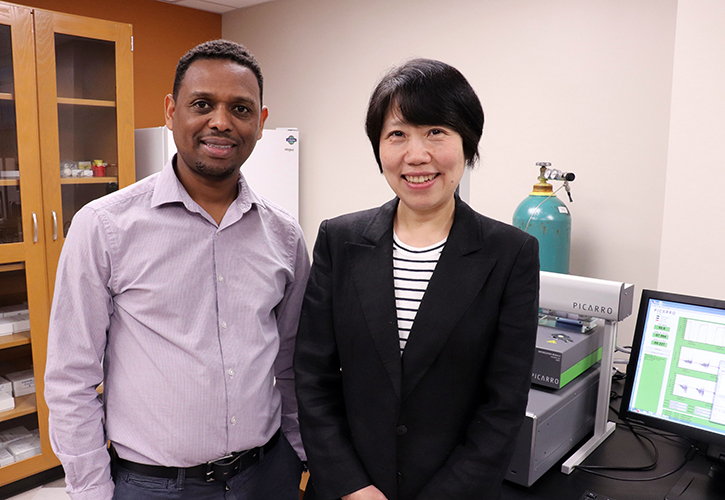College of Arts and Sciences Newsroom

Geoscientists awarded $309K to study Horn of Africa water sustainability
By Dave Larsen
The Horn of Africa has experienced severe droughts in recent decades, leading to devastating socio-economic consequences for the continent’s easternmost peninsula, which is dominated by rain-fed agriculture.
The National Science Foundation awarded two University of Dayton researchers a three-year, $308,799 grant to establish a link between rain-producing climate patterns and water supply in the region, which includes Somalia, Ethiopia, Eritrea and Djibouti. The grant started May 1 and runs through April 2025.
The goal of the project is to understand the current availability and future sustainability of water resources in the region under climate change.
“The knowledge we obtain from this project will facilitate better planning for water resources, and also help decision and policy making for the sustainable development of Ethiopia, particularly in terms of increasing food security and reducing vulnerability,” said Zelalem Bedaso, assistant professor of geology.
Bedaso, an isotope geochemist, is collaborating with climate scientist Shuang-Ye Wu, professor and chair of the Department of Geology and Environmental Geosciences. The project also will involve nine University of Dayton undergraduate students, including three who will travel to their research site in Ethiopia, as well as an exchange with faculty and students from Bahir Dar University in northern Ethiopia.
“Students will get experience in scientific research, working in a group, learning to work with other scientists, but also it promotes global learning,” Bedaso said.
Bedaso and Wu tested their approach with a 2019 study published in the Hydrological Science Journal about the future sustainability of the Dayton region’s groundwater. That project was supported by a grant from the University of Dayton Hanley Sustainability Institute.
In mid-May, Bedaso and Wu will travel to Ethiopia for several weeks to meet with local research partners, obtain permits and set up their sample collecting stations before the June 1 start of the long rainy season. They will work in the Omo-Gibe River Basin, which has one rainy season in the north and two rainy seasons in the south.
“That’s a really unique basin that can capture all of the variabilities that we need for data collection and modeling,” said Bedaso, the project’s principal investigator. “We will have at least five monitoring stations to collect surface and groundwater isotopes throughout the year.”
Wu, co-principal investigator, specializes in climate modeling. In the first phase of the project, she will broadly categorize the climate patterns that produce rain, based on data and statistical models.
“The rainfall pattern in that region, East Africa in general, is very complicated,” Wu said. “We will use modern technology to categorize them into different types of rain and then see whether they have different historical trends. That, hopefully, will help us refine the future projection of rainfall.”
In the second phase of the project, they will use rainfall isotopes as a tracer to determine how much rainfall gets into streams and is stored in groundwater.
“During heavy rainfall events, much of the rain becomes runoff and drains into streams,” Wu said. “Whereas moderate and small rainfall events could lead to a higher proportion of groundwater recharge.”
The final phase will link their findings to establish distinct signatures of rainfall from different weather types, and quantify their specific contribution to surface flow and groundwater recharge. These results will allow them to determine how precipitation and water resources change with global warming in the region.
“That is the end objective, to look at the long-term sustainability of water resources for a region where water is scarce and agriculture is mostly dependent on rainfall,” Wu said.
The National Science Foundation (NSF) award is the second in recent months for Bedaso. Last fall, he received a three-year, $156,776 grant to study seasonal rainfall variability during the last 200,000 years in East Africa to understand the impact of extreme weather on early humans and the ecosystems on which they depended. He plans to remain in Ethiopia for an additional month this summer to conduct research for that study.
Bedaso and Wu hope to return to Ethiopia in December, at which time they may start bringing students, at a rate of one per year.
“We are an undergraduate department, but our faculty are all very productive,” Wu said. “We have NSF and NASA grants. So, partly by necessity, one of our missions is to involve undergraduates in all these high-level research projects.”
For more information, visit the Department of Geology and Environment Geosciences website.
Photo (left to right): Zelalem Bedaso and Shuang-Ye Wu.
